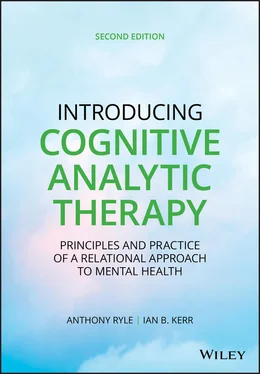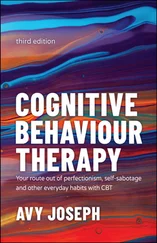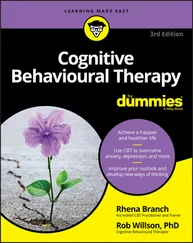The CAT model of Self and its formation shares much with the different conceptions of self formulated historically by various clinical writers. These would include notably Jung (see Samuels, 1985), although Jungians have tended to neglect the social dimensions of the self, Sullivan (1953) within the North American “interpersonal” tradition, and Kohut (1977). CAT shares with Kohut an emphasis on the damage which can be done to the developing self by empathic failure or overt neglect but places more emphasis on active abuse and trauma. CAT also shares a central interest in social conceptions of the self with group analysts. Foulkes, for example, saw individuals in a social fashion as being nodes in a “social matrix” (Foulkes & Anthony, 1957). Later group analytic writers (e.g., Brown & Zinkin, 1994; Pines, 1996) have also developed an interest in the (Bakhtinian) dialogic aspects of the self.
Although object‐relations theorists were a major influence on the development of CAT, they were on the whole little interested in the concept of self. However, the current CAT model is close to some later authors in the object relations tradition, such as Sutherland (1980), Ogden (1990), and Sandler and Sandler (1998). It is also close to Bowlby's attachment theory (1988) and to subsequent work influenced by this (Fonagy & Target, 1997; and see Bateman, Brown, & Pedder, 2000) in their descriptions of the important role of internalization, and there are some similarities with more recent developments in cognitive psychology stressing the importance early interpersonal experience and of attachment patterns (see Gumley & Schwannauer, 2006; Guidano, 1987, 1991; Liotti, Cortina, & Farina, 2008; Neisser, 1993; Perris, 2000; Young, Klosko, & Weishaar, 2003). However, these authors do not take the further, and, in our view, important, conceptual leap of seeing the self as being essentially constituted by early, socially meaningful, sign‐mediated interpersonal experiences, as opposed to “representing” them mentally.
Nonetheless, object‐relations theories made a considerable contribution by indicating the importance of early development in determining personality, by offering an account of how parental figures were “internalized” to form a part of the personality, and by recognizing the parallel, linked features of intrapsychic and interpersonal processes and their emergence in transference relationships (see also discussion in Ryle, 1996, 1997c). However, the attribution of these phenomena by some psychoanalytic object‐relations theorists to “splitting” and “projective identification,” and the location of “psychopathology” in the posited internal system of object relations and to “ego weakness,” innate destructive instinctual forces, and unconscious fantasy is seen as unhelpful and untenable from a CAT perspective. The phenomenon of projective identification, whereby others are powerfully induced to experience feelings or play roles which the person cannot tolerate, is not regarded as a defense in CAT; it is seen to represent an exaggerated example of the normal empathic processes of RR relating. CAT understands Self states (dissociated RRs) to be precarious and to leading the person to induce powerful identifying responses in, or to forcefully seek reciprocations from, others even where these are harmful. While usually discussed in relation to destructive procedures, CAT would understand that the same intense pressures can characterize the seeking for “good enough” or ideal care.
Cognitive Psychology and Cognitive Therapy
One important early influence in the development of CAT was personal construct theory (Kelly, 1955), an approach which challenged both psychoanalytic and behavioral assumptions and which, especially if linked with social constructivism, goes some way toward acknowledging the specifically human, cultural influences on personality. The dominant cognitive theory of the last decades, however, influenced by artificial intelligence research and computer metaphors, has been concerned with information processing and storage. In our view this is still largely the case, although some authors began to show an increasing interest and awareness of the effects of early interpersonal experience and of the importance of (social) meaning in development and in therapy (see Brewin, 1988; Salkovskis, 1996; Safran & McMain, 1992; Stiles, 1997; Perris, 2000). An important contribution of these cognitive and behavioral theories to the CAT model was their demonstration of the value of analyzing and describing sequences (for example, linking behaviors to outcomes, cognitions to emotions) and their demonstration that many problems can be understood without postulating unconscious forces. The cognitive component of CAT theory was derived initially from the work with repertory grids and, to a degree, from personal construct theory. Miller, Galanter, and Pribram (1960) and Neisser (1967) were also significant influences. In Ryle (1982), the Procedural Sequence Model (PSM) was compared in some detail to Beck's model of cognitive therapy (Beck, 1976), to Roth's model of learned helplessness (Roth, 1980), to Rehm's model of depression (Rehm, 1977), to Rotter's model of generalized expectancies (Rotter, 1978), to Forstelling's attribution theory (Forstelling, 1980), and to Bandura's model of self‐efficacy (Bandura, 1977). In terms of practice, the use of patient self‐monitoring was derived from Beck and became one important aspect of the reformulation process, but in CAT the focus of attention was shifted as soon as possible from symptoms to procedures.
Later developments in cognitive‐behavior therapy (CBT), for example the work of Guidano (1987) or Neisser (1993) focusing on a concept of self, and those stressing the importance of early interpersonal experience and of attachment patterns, including in relation to dissociation (see Gumley & Schwannauer, 2006; Liotti et al., 2008; Perris, 2000), or interpersonally‐derived “schemas” (Young et al., 2003), or even those seeing the self as a set of information processing systems (Prescott, 2015), show some convergences with CAT. This would include clinical work noting and addressing ways in which so‐called “therapy interfering behaviors” or “resistance” may arise (Leahy, 2001). These have to some extent shifted attention to higher level functions and more complex disorders but important differences remain, as will become clear in later chapters. Notably, such approaches still lack, in our view, a clear and coherent means of understanding and effectively addressing “therapy interfering behaviors,” “resistance,” or therapeutic challenges and ruptures in a productive and non‐blaming way (see also Chapter 9).
The early CAT model (PSM) therefore resembled cognitive ones but differed essentially in that the unit of observation—the procedural sequence—involved linking together environmental, mental, and behavioral phenomena and their implicit underlying relational origins. The level of address in CAT is on whole‐person Self processes and structures understood in developmental and contextual terms, whereas CBT remains usually focused on particular beliefs, symptoms, or behaviors and pays little attention to development or structure, or to socio‐cultural context. Some important differences deriving from these and as manifest in the clinical practice of CBT and CAT are further considered in Chapter 9.
It is well documented by behavioral geneticists, as well as by evolutionary psychologists, that we arrive in this world with a considerable psychological “baggage” in the form of both individual temperamental characteristics and also more general evolutionary predispositions to behave in certain ways in certain situations (Aitken & Trevarthen, 1997; Braten, 2013; Gilbert, 1992; James, 2018; McGuire & Troisi, 1998; Plomin, 1994, 2018; Stevens & Price, 1996). Thus, the human infant is very far from being a completely malleable and motiveless naive being or “tabula rasa.” Some of the variance in observed patterns of human behaving and thinking (personality) is due to variation in inherited temperamental factors. Of these, the so‐called “big 5” (neuroticism, extraversion–introversion, openness to experience, conscientiousness, and agreeableness) are perhaps the best known and documented (Costa & McCrae, 1992). It is similarly clear that a varying but significant amount of the variance in the prevalence of frank mental disorders is due to genetic factors. It was previously suggested that this may range from about 0.5 (i.e., about half) for manic depression and the schizophrenias (e.g., as tested in identical twins reared apart) to much lower but still significant figures for “neurotic” disorders such as depression and anxiety (see also discussion by Plomin, 1994, 2018). More recent work has, however, challenged these estimates (see James, 2018), which apparently remain uncertain. Plomin makes the interesting point that in social settings characterized by, for example, pervasive inequalities, some more subtle genetic effects may be obscured that when understood may also enable us to better address these social effects (Plomin, 2018). However, it has also been argued, in the light of the relative failure of genetic mapping projects to identify clear dominant loci associated with mental disorder, that the genetic causes of common mental disorders have been greatly overstated and are in fact minimal (James, 2018). Even for major psychotic disorders the results of genome wide association studies appear currently to suggest that subtle effects are caused only collectively over a large number (more than a hundred) of genetic loci (Schizophrenia Working Group, 2014). These figures also indicate the need to understand what sort of factors contribute to the greater remainder of the variance.
Читать дальше












